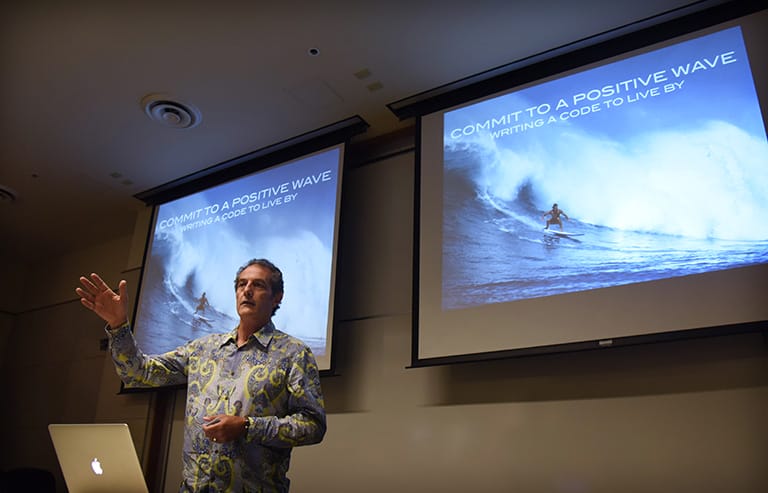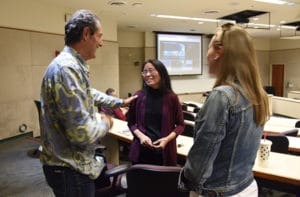Surf Champ Shaun Tomson to Students: I Need Your Help

In the 1970s, Shaun Tomson played a key role in revolutionizing and raising the profile of surfing.
He’s been called many things—the master of the tube, Mr. JBay (Jeffreys Bay is a hot surfing spot in his native South Africa), one of the 10 greatest surfers of all time … the list of accolades is nearly endless.
Today, Tomson is pursuing a different kind of wave—one related to positivity and self-empowerment. The 1977 International Professional Surfers World Champion visited Claremont Graduate University this month to share his mission with an audience of students and faculty with the talk “Commit to a Positive Wave: Writing a Code to Live By.”
The event was sponsored by the CGU Claremont Evaluation Center’s Positive Organizational Development Lab.
“What if we can make a difference in the world? What if we can make a dent in the millions of lives that have been lost by people making bad choices?” Tomson asked the audience. “I know the Code works, but I don’t have the academic credentials, the firepower, to validate it like you do.”
Tomson referred to a grim statistic: 1 million out of 2.4 million American deaths every year are caused by a range of poor personal decisions that could have changed had the victims realized there were other options. His response has been “The Code,” a set of affirming principles that every person makes. Each code is unique because each person drafts their own to chart their future and sense of self-worth.
“It’s really simple,” said Tomson, 61, with a soft South African English accent that he hasn’t lost after 20 years in the United States. “The Code is this: ‘What you will, you will become.’”
A Code to Live By
During the April 13 presentation, Tomson described his journey to the top of surfing’s pyramid in the 1970s—how he mustered the willpower to compete with the best and conquer his fear of Hawaii’s Banzai Pipeline, which he says is “the gateway to greatness”—and the tragic loss of his 15-year-old son Mathew in 2006 that inspired his mission to create the Code.
The other inspiration behind the code, he said, was his project to raise awareness about sewage problems around Santa Barbara’s famous surf spot at Rincon. Tomson made small cards printed with a “Surfer’s Code” and handed them out to locals and visitors. Tomson wrote out all of the code statements for that card (each begins with “I will”: “I will never turn my back on the ocean … I will realize that all surfers are joined by one ocean.”) and that message of harmony with the natural world resonated with people. Demand for the cards quickly grew.
Tomson’s initial effort soon changed into something even greater: a campaign to inspire schoolchildren here and in South Africa to activate their positive energy and to transform corporate culture by teaching executives and their teams to become “the best version of yourself.” Along the way, he wrote two books about it, Surfer’s Code and The Code: The Power of ‘I Will.’
“The Code represents what you are, and what you can become,” he explained.

The CGU Connection
Tomson first connected with CGU prior to his April talk.
In January, when he attended the Western Positive Psychology Association conference held at CGU, Tomson said he realized he was in the right place when School of Social Science, Policy & Evaluation Dean Stewart Donaldson described positive psychology as the “science of optimal organizational functioning and flourishing.”
“What Stewart said really struck me,” Tomson said. “I’d been riding my wave on instinct for years, without the scientific principles he described.”
In the months after the conference, Tomson met with Donaldson and Division of Behavioral & Organizational Sciences Professor Kendall Cotton Bronk to further discuss the Code. Donaldson and Bronk attended Tomson’s presentation, along with Associate Professor Jeanne Nakamura and Mihaly Csikszentmihalyi, a co-founder of positive psychology and CGU’s Distinguished Professor of Psychology and Management. Nakamura and Csikszentmihalyi run the university’s Quality of Life Research Center.
“It has always fascinated me,” Donaldson said in his introduction of Tomson, “how the founders of different fields have found their way onto our campus.”
He mentioned three CGU founders—Peter Drucker, Michael Scriven, and Csikszentmihalyi—and then added Tomson, joking that he couldn’t believe that “Shaun Tomson was actually willing to drive this far inland to Claremont to see what we’re doing.”
During Tomson’s talk, the former professional surfer told the audience how he’s witnessed the power of positive action in schoolchildren and adults around the world, but hopes to work with the university’s positive psychology cohort on scientific support for his countless anecdotes of his code changing people’s lives.
Some of the most memorable moments in Tomson’s talk, of course, involved surfing.
He described the exuberance of leaping into the African waves with a red sun “seeming to boil up out of the water,” the feeling of timelessness inside a perfect tube, the burst of spray leaving a tube that feels “like the breath of God,” and peering over the edge of Banzai pipeline and pulling back “because I couldn’t bring myself to make that final commitment.”
It was also clear, from the way he described the code and his efforts to honor his son’s memory, that Tomson has found an exuberance and joy in his mission that is similar to what he feels when he’s surfing.
“When you drop that little stone in the water,” Tomson said about this work, “and that ripple touches someone, man, that is what life is all about.”